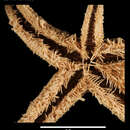en
names in breadcrumbs


“Asterias (Smilasterias) triremis, n. sp. (Pl. CI. figs. 5 and 6; Pl. CI I. figs. 5 and 6).
Rays five. R = 35 mm.; r = 5.5 mm. R >6 r. Breadth of a ray at the base about 7 mm.
Rays elongate, tapering, convex, and apparently subcylindrical abactinally, but flattened actinally. Disk small and convex, often more or less tumid and higher than the base of the rays. Interbrachial arcs acute.
The abactinal area is covered with small plates, the major diameter of which is usually transverse in relation to the ray, showing a more or less distinct tendency to form longitudinal series along the ray. A median radial series is more or less indistinctly indicated by a faint ridge, and on the sides of the rays a regular arrangement in longitudinal as well as transverse series occurs. Several small, uniform, papilliform spinelets are borne on each plate, well spaced apart, and several small forcipiform and forficiform pedicellarae which at first sight can hardly be distinguished from the spinelets; the whole forms a uniform papillose covering to the abactinal surface in which no definite order of arrangement can be detected. On the plates that I consider to be the representatives of the supero-marginal plates there are generally one or two spinclets definitely placed, which may stand as an oblique pair, the series forming a regular longitudinal line along the ray. Between the supero-marginal and the infero-marginal plates, there are on the inner part of the ray in large examples one or two series of intermediate plates, separated by papulae, the spinelets on which show a tendency to fall in lineal transverse series. On the abactinal area generally single papulae occur between the plates.
The infero-marginal plates, which stand at the junction of the lateral and actinal areas, form a regular longitudinal series along the ray. Each plate beam an oblique series of three short, compressed, flaring, truncate, chisel-shaped spinelets, which radiate slightly apart, and form an oblique comb at the margin of the ray. Sometimes the truncate extremity of the spinelet is more or less crenulate or denticulate.
The adambulacral plates are contingent on the infero-marginal plates. Their armature consists of two moderately robust, equal spinelets, which stand one behind the other and radiate apart, forming two regular longitudinal series on each side of the furrow. The outer spine of the pair is usually more or less compressed and chisel-shaped, resembling the spinelets on the infero-marginal plates, but is not so broad; the inner spine, on the other hand, is generally subcylindrical, tapering, but rather obtusely pointed, and skin-covered. At the base of the inner series of spines, and rather high in the furrow, is a series of small forficiform pedicellariae. Occasional isolated forficiform pedicellariae are present between the outermost spines on the adambulacral plates and the comb of spines on the infero-marginal plates. And one or even more very large robust forficiform pedicellariae may not infrequently be found in the narrow actinal interradial area behind the mouth-plates. Several large forficiform pedicellariae with broad, curved, denticulated, interlocking extremities, may generally be found on the disk at the summit of the inter-brachial arc.
The madreporiform body is small, and situated near the margin of the disk. It is grooved with comparatively few, coarse, convoluted striations, and its periphery, which is circular, is surrounded by a circlet of spinelets.
The ambulacral furrows are wide, and the tube-feet, which have a fleshy terminal disk, are quadriserially arranged.
Colour in alcohol, a bleached ashy grey or white, with occasional darker tints suggestive of a violet colour during life.
Locality.—Station 150. Between Kerguelen and Heard Islands. February 2, 1874. Lat. 52° 4' 0" S., long. 71° 22' 0" E. Depth 150 fathoms. Coarse gravel. Bottom temperature 35.2° Fahr.; surface temperature 37.5° Fahr.
Remarks.—This species is nearly allied to Asterias (Smilastericts) scalprifera, but is distinguished by the smaller habit, by the more compactly papillose character of the abactinal spinulation, and by the constant presence of only three spines in the oblique combs on the infero-marginal plates, and only two spines in the armature of the adambulacral plates, irrespective of the size of the example. I was at first inclined to think that this form might perhaps be the young stage of Asterias (Smilastericts) scalprifera, but the constancy of the characters above noted throughout the large series of examples collected appear to me, after a careful study, to warrant the recognition of Asterias (Smilastcrias) triremis as a distinct species.”
(Sladen, 1889: 579-581)